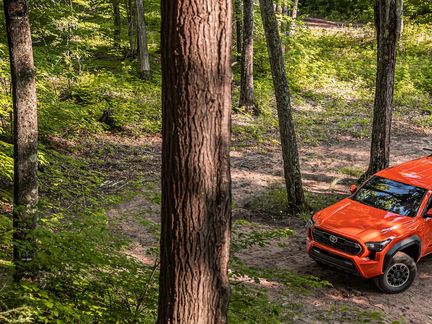Free Shipping on Orders Over $100
LT Tires Vs. P Tires For Trucks, Vans, and Jeeps
Updated on Nov 13, 2025
Locking down the perfect tires for your ride can be a hassle, especially with the added strain of comparing LT and P sizes! LT (Light Truck) and P (Passenger) tires feature several specific benefits over the other. Depending on variables like the class of vehicle you drive and the terrain you typically pilot your vehicle across, one option may suit your needs better than the next.
In this article, we’ll look at the key characteristics of LT and P tires, comparing and contrasting their strengths and weaknesses to help narrow down which tire is right for you. To learn more about these standard tire types, read on! And as always, click here to browse our extensive tire inventory.
LT (Light Truck) Tires
The main characteristic that sets light truck tires apart from standard passenger tires is their construction. LT tires feature more-rigid sidewalls and deep tread lugs for extra durability and traction in extreme conditions.
Despite their title, light truck tires can be used across various vehicles, including mid-size, full-size, and heavy-duty pickups, SUVs, and vans. Generally, light truck tires are ideal for vehicles that regularly carry heavy loads or trek across extreme terrain. Due to the stiff, multi-ply sidewalls, LT tires are resistant to flexing and punctures, making them ideal for an adventure rig, hunting truck, or heavy hauler.
LT tire sizing can also differ from traditional P-metric sizing. Instead of using a combination of imperial and metric measurements, some LT tires are measured only in imperial units. For example, a 35x12.50r15 LT tire measures 35-inches tall, 12.50-inches wide, and fits a 15-inch diameter wheel.
LT Tires Pros and Cons
For easy viewing, let’s briefly recap the major pros and cons of LT tires.
Pros
Durable multi-ply sidewalls
Deep tread grooves for increased traction
High load rating
Cons
Considerably heavy
Reduced fuel efficiency
Rough ride quality
Typically priced higher
P (Passenger) Tires
Where once passenger tires were only recommended on light, passenger vehicles–such as compact, mid-size, and full-size cars, crossovers, and compact SUVs–modern passenger tires are found across nearly every class of vehicle.
P (passenger) tires are characterized by their mild construction, engineered for fuel efficiency, on-road traction, and excellent ride quality. Typically, passenger tires are constructed with thinner sidewalls and shallower tread lugs than comparable LT tires, making for a more-flexible tire carcass and, thus, improved ride quality.
However, the reduction of sidewall thickness and tread depth makes for a lower load capacity and reduced traction in extreme conditions.
P (Passenger) Tire Pros and Cons
Here’s a quick pros and cons list to help you decide if P tires better suit your vehicle.
Pros
Comfortable ride
Increased fuel efficiency
Excellent on-road performance
Lightweight
Typically priced lower
Cons
Reduced durability
Reduced traction off-road
Reduced load rating
What’s Your Budget?
Budget is always a worthwhile consideration when selecting a new set of tires for your vehicle. If you’re looking to save a few bucks and P-metric tires fit your driving style/conditions, consider a set of passenger tires over their light truck counterparts.
Regarding modern tires, you can’t go wrong with either P (passenger) or LT (light truck) sizes; however, one variation may suit your needs better than the other. Hopefully, this guide has aided you in your next tire purchase, and for all your tire needs, don’t forget to check out RealTruck’s wide selection of LT and P tires.
Shop Now
RealTruck is your home for the best products to outfit your build for unforgettable adventures.
See More Guide Articles Here...
- …
Join over 2 million RealTruck people
Get exclusive savings, insider information, and the latest RealTruck articles sent straight to your inbox.



